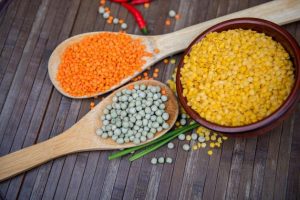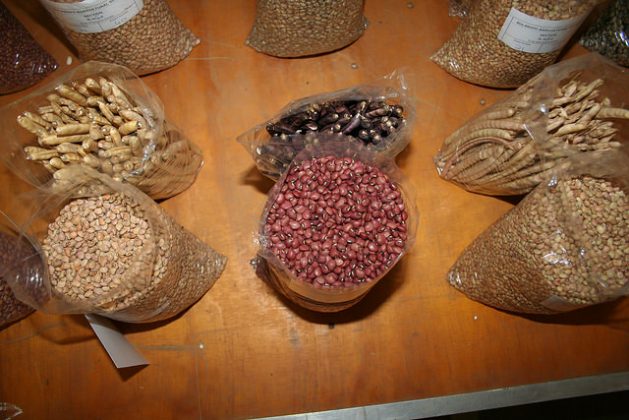Many Good Reasons to Eat More Pulses – And Perhaps Less Meat!
 9 Februari 2022
9 Februari 2022

Pulses provide nutrients and energy and they help prevent diseases like diabetes and coronary conditions. The United Nations declared 10 February World Pulses Day.
By Baher Kamal
MADRID, Feb 9 2022 (IPS)
Pulses and meat are both needed as part of your diet, however… While the total emissions of greenhouse gases from global livestock amount to 7.1 Gigatonnes of Co2-equivalent per year, representing 14.5% of all anthropogenic emissions, pulses have root nodules that absorb inert nitrogen from soil air and convert it into biologically useful ammonia, a process referred to as biological nitrogen fixation.
Moreover, cattle (raised for both beef and milk, as well as for inedible outputs like manure and draft power) are the animal species responsible for the most emissions, representing about 65% of the livestock sector’s emissions, according to a report by the UN Food and Agriculture Organisation (FAO).
Pulses, instead, provide nutrients and energy and they help prevent diseases like diabetes and coronary conditions.
“They are rich in proteins and minerals, have high fiber content and low-fat content, and no cholesterol. The carbohydrates in pulses are absorbed and digested slowly, and thus help control diabetes and obesity.”
Meat, instead…
Back to livestock, the Organisation says that, in terms of activities, feed production and processing (this includes land use change) and enteric fermentation from ruminants are the two main sources of emissions, representing 45% and 39% of total emissions, respectively.
And that manure storage and processing represent 10%. The remainder is attributable to the processing and transportation of animal products.
Protein for the poor
In many cultures, pulses are considered as ‘protein for the poor’ and their high nutrient content makes them ideal for vegetarians and vegans to ensure adequate intakes of protein, minerals and vitamins, says FAO.
In addition to their function and role in reducing greenhouse gases emission, the world body highlights the following ten great benefits:
- Pulses are naturally low in fat and contain no cholesterol, which can contribute to reducing the risk of cardiovascular diseases.
- Pulses are also low in sodium. Sodium chloride – or salt – is a contributor to hypertension and can be avoided by consuming foods with lower sodium levels such as pulses.
- They are a great source of plant-based protein. Surprisingly, 100 grams of dry lentils contain a remarkable 25 grams of protein! During cooking, pulses absorb considerable amounts of water thus reducing their protein content to around 8 percent.
Yet, you can still increase the protein quality of cooked pulses by simply combining them with cereals in your meal, for example, lentils with rice.
- Pulses are a good source of iron. Iron deficiency is considered one of the most prevalent forms of malnutrition and is one of the most common types of anaemia. To help optimise the absorption of iron in our bodies from pulses, combine them with foods containing vitamin C (lemon juice on lentil curry for example).
- Pulses are high in potassium, which supports heart health and plays an important role for digestive and muscular functions.
- Pulses are often quoted among the top high fiber foods, necessary for supporting digestive health and helping to reduce the risks of cardiovascular diseases.
- Pulses are an excellent source of folate – a B-vitamin naturally present in many foods – that is essential to the nervous system function and especially important during pregnancy to prevent fetal defects.
- Pulses can be stored for a long time and therefore can help to increase the diversity of diets, especially in developing countries.
- Pulses are low glycaemic index foods. They help to stabilize blood sugar and insulin levels, making them suitable for people with diabetes and ideal for weight management.
- Finally, pulses are naturally gluten-free. This makes them an ideal option for coeliacs.
A full World Day for pulses
The United Nations declared 10 February World Pulses Day, keeping alive the positive momentum surrounding these healthy, nutritious and protein-rich legumes after FAO’s successful International Year of Pulses Campaign in 2016.
“They are our delicious ally in achieving food security, reducing malnutrition and creating a #ZeroHunger world.”
Love for pulses
“There is a lot to love about pulses! They are inexpensive, healthy, environmentally-friendly and, last but not least, tasty!”
“Red, green, white, black, brown… name a colour and we can give you a pulse! And what exactly is a pulse, you might ask? Well, pulses are a sub-group of legumes that are harvested for their dry seeds. Beans, lentils and peas are commonly known pulses.”
“But the world of pulses is much more than that! From lupins to lentils or cowpeas to chickpeas, pulses can surprise you with their breadth and depth,” explains the Food and Agriculture Organisation.
No matter whether they have an alluring name like velvet beans or a curious one like winged beans, pulses are wonderful foods for both human and environmental health, FAO underlines.
Vital and inexpensive
“They are a vital and generally inexpensive source of protein. They are full of vitamins and minerals that can help prevent diseases like diabetes and coronary conditions.”
Planet-wise, it adds, pulses are good for soil health, and many are also drought resistant and climate-resilient, their genetic diversity helping them adapt to changes in climate.
Less popular now!
Despite the many benefits, these extraordinary foods have lost popularity in recent years and worldwide consumption has decreased because of rising incomes and related consumer preferences, reports the world body.
Anyway, you surely know how to cook pulses. However, should you want to learn more, please click here: Pulses recipes from around the world!

